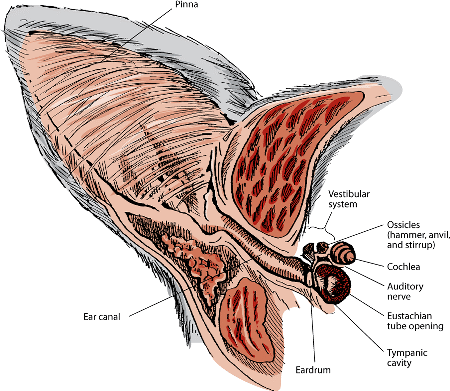Ear Structure and Function in Cats
- Ear Disorders of Cats
- Ear Structure and Function in Cats
- Deafness in Cats
- Disorders of the Outer Ear in Cats
- Otitis Externa in Cats
- Otitis Media and Interna in Cats
- Tumors of the Ear Canal in Cats
Cats are very sensitive to sound, with a range of hearing both above and below the range of frequencies that can be detected by humans. They can hear better than people and even better than most dogs.
The ear is an organ of hearing and an organ of balance. It consists of the outer, middle, and inner ear.
The outer ear includes the pinna (the part you see that is made of cartilage and covered by skin, fur, or hair) and the ear canal. The pinna is shaped to capture sound waves and funnel them through the ear canal to the eardrum. In cats, the pinnae are mobile and can move independently of each other. The ear canal of cats is deeper and more tapered than in people, creating a better funnel to carry sound to the eardrum. This deeper canal is subject to buildup of dirt and wax that can lead to inflammation and secondary infection, although to a lesser degree than in dogs.
The middle ear includes the eardrum and a small, air-filled chamber that contains 3 tiny bones: the hammer, anvil, and stirrup. It also includes 2 muscles, the oval window, and the eustachian tube (a small tube that connects the middle ear with the back of the nose, allowing air to enter the middle ear).
The inner ear is a complex structure that includes the cochlea (the organ of hearing) and the vestibular system (the organ of balance). The semicircular canals, which are found within the inner ear, are filled with fluid and are important for maintaining balance. These are highly developed in the cat, accounting for its agility and excellent sense of balance.
Physical Examination of the Ear
Your veterinarian will examine your cat’s ears at every routine checkup. If the cat has a history of previous ear infections or other problems with the ear, you should provide that information to the veterinarian.
To start, your veterinarian will visually inspect the outer ears, noting any signs of inflammation, injury from trauma, swelling, secretions, or excessive ear wax. He or she will then use an instrument called an otoscope to view the ear canal and eardrum. A video-otoscope (an otoscope with a camera that can display images of the inside of the ear) is often very helpful when inspecting the ear canals. It may be necessary to use sedation or general anesthesia to examine some cats if the ear is painful and the cat is difficult to restrain. If an infection is suspected, tests will be performed on samples of fluid or secretions from the ear to determine the organisms involved and the proper treatment. Infections in cats’ ears are most commonly caused by bacteria or yeasts.
To diagnose a tumor of the ear, it may be necessary to do a pinch biopsy to obtain tissue for evaluation. This can usually be done using forceps and an otoscope while the cat is under general anesthesia. Further tests, including x-rays, neurologic tests, and electronic tests may be needed to confirm certain conditions such as deafness.
Resources In This Article
- Ear Disorders of Cats
- Ear Structure and Function in Cats
- Deafness in Cats
- Disorders of the Outer Ear in Cats
- Otitis Externa in Cats
- Otitis Media and Interna in Cats
- Tumors of the Ear Canal in Cats






